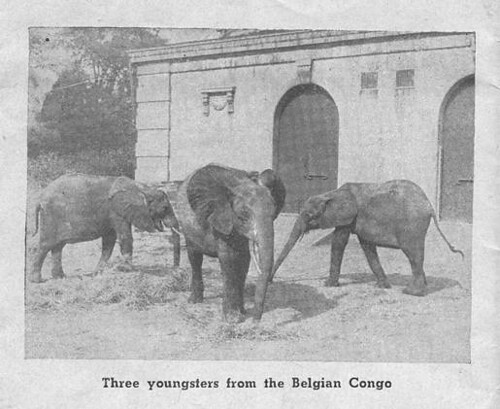| These are the three Africans obtained by the Bronx zoo in 1946 from Gangala na Bodio, Belgian Congo. Two are cyclotis and the third a common bush elephant. This photo was taken in late 1946 or early 1947. |
Sunday, July 29, 2007
From Richard Reynolds
Posted by
Buckles
at
7/29/2007 08:01:00 PM
![]()
Subscribe to:
Post Comments (Atom)






3 comments:
Richard, is the bush elephant the small one on the right?
Mr. Reynolds; What would be the distingushing characteristic between these two species of African elephant5s? Would they each have separate areas in the wild that would be exclusive to maintaining this separation of the species?
Richard Reynolds answers - -
This trio of Africans arrived at the Bronx on October 8, 1946 from the elephant training station at Gangala-na Bodio, Belgian Congo. One (the animal on the left) was a common bush elephant but the other two were a male and female of the rare forest elephant (Pygmy elephants to Roland Butler). The male, facing the camera, was named Zangalima and to his right is the female Dourma - -Pinky to the keepers.
In taxonomy, the forest elephant is now called “Loxodonta cyclotis” or “cyclotis” for short. They range across the African rain forest from the Belgian Congo on the East to the lands round the Gulf of Guinea in the West. They are much different than common bush elephants which are called “Loxodonta africana.”
The ears are distinguishing characteristics. Note how the two cyclotis in the photo have very rounded ears whereas the bush elephant (on the right) has ears that look like an old fashioned ladies hand-held fan, when spread out. They come to a sharp point at the bottom. Also the tusks of cyclotis often point straight down behind the trunk. Cyclotis has 5 nails on the front feet (like Asian elephants) whereas the bush elephant has only 3. Also, when adult, cyclotis is usually nowhere nearly as large as the bush elephant.
For many years it was thought that cyclotis was only a jungle race of the big bush elephant. Now, however, genetic studies show that it is an entirely separate species, no more related to the big bush elephant than a tiger is to a lion. Presently, there are no cyclotis in captivity in USA. The last one, Bud, died in the Columbus, OH zoo on Nov. 10, 1991. He had the typical well rounded ears but curved tusks which are atypical.
The dearth of cyclotis hereabouts was not always the case. Beginning in 1925, the Belgians opened elephant training stations in the Congo, first at Api and later at Gangala-na-Bodio. This made them fairly easy to obtain and quite a few of them came to USA. In 1960 the Belgian Congo became independent. That brought awful strife and civil war. The training stations were a casualty. I have heard that the remaining elephants at Gangala were slaughtered
As far as I can determine, there is now only one cyclotis in captivity anywhere in the world. That would be the male “Can,” captive bred and born in 2000 at the zoo in Abijan, Ivory Coast.
Post a Comment